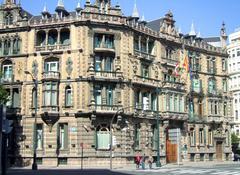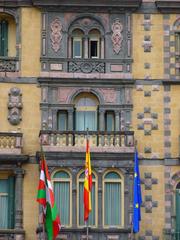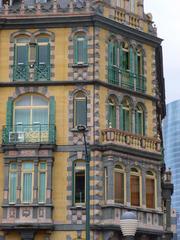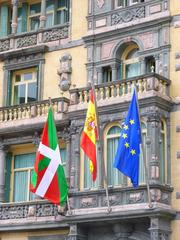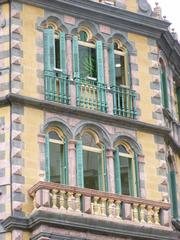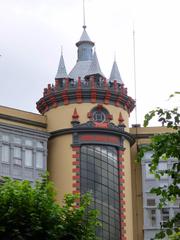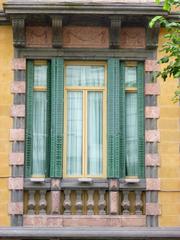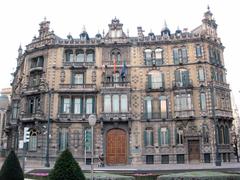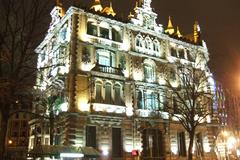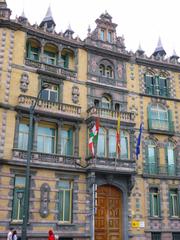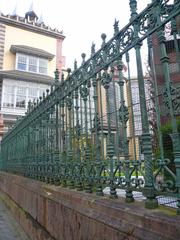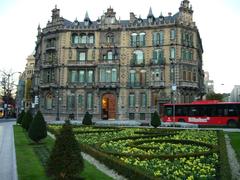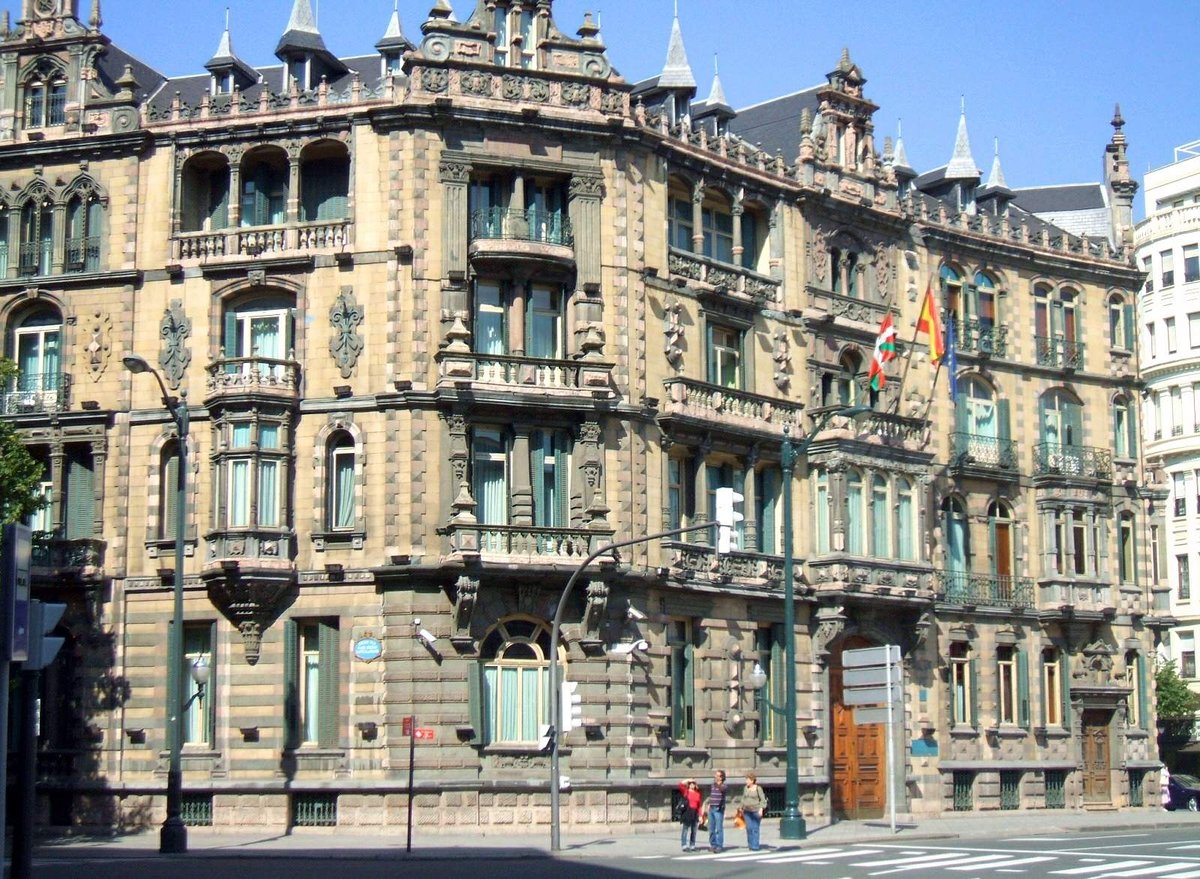
Chavarri Palace Bilbao: Visiting Hours, Tickets, and Historical Sites Guide
Date: 14/06/2025
Introduction
Chavarri Palace (Palacio Chávarri) stands as one of Bilbao’s most distinguished historical landmarks, reflecting the city’s dramatic transformation from a small fishing village to a thriving industrial and cosmopolitan center in the late 19th century. Commissioned by industrialists Víctor and Benigno Chávarri, and designed by Belgian architect Paul Hankar, the palace is an outstanding example of Flemish Neo-Renaissance style—a rarity in Spain. Its asymmetrical façade, polychrome stonework, and rich ornamentation evoke the grandeur of Northern European civic buildings. Located on Plaza Moyúa, the palace not only symbolizes the Chávarri family’s status but also anchors Bilbao’s modernization and urban expansion.
Although Chavarri Palace currently serves as a government building with limited public access to its interior, its striking exterior is accessible at all times and remains one of the most photogenic and celebrated sites in the city. Guided tours, offered on select dates, provide rare glimpses into its ornate interiors. This guide explores the palace’s origins, architectural features, role in Bilbao’s history, preservation efforts, and essential visitor information—including visiting hours, ticketing, accessibility, and nearby attractions. For further details, consult Bilbao Turismo and Barceló Guide.
Table of Contents
- Historical Background and Significance
- Architectural Features and Urban Role
- Interior Highlights
- Visitor Information: Hours, Tickets, Tours, and Accessibility
- Practical Tips and Local Attractions
- Frequently Asked Questions (FAQ)
- Summary and Recommendations
- References
Historical Background and Significance
Chavarri Palace was constructed between 1888 and 1894 for Víctor Chávarri—a key figure in Bilbao’s industrial ascent—and his brother Benigno. The Chávarri family, originally from the Basque Country, accumulated their wealth through mining, steel, and shipping, sectors that fueled Bilbao’s late 19th-century boom (ibnbattutatravel.com). The palace’s prominent site on Plaza Moyúa symbolized both the family’s social standing and Bilbao’s new era of prosperity.
After decades as a private residence, the palace was repurposed in 1943 as the seat of the Spanish Government’s delegation in Biscay. This transition from private mansion to public institution underscores its continued civic importance (Minube).
Architectural Features and Urban Role
Flemish Neo-Renaissance Style
Designed by Paul Hankar, Chavarri Palace stands out for its eclectic Flemish Renaissance style, an architectural language rarely seen in Spain. The asymmetrical façade, vibrant polychrome brickwork, intricate stone carvings, steep gables, dormer windows, and decorative ironwork all contribute to its uniqueness (mikestravelguide.com). Notably, each window and balcony is distinct, showcasing the creative ambitions of its designers (Don’t Worry Just Travel).
The palace’s steeply pitched roof and distinctive silhouette make it a visual anchor in the cityscape, while the rear private garden offers a tranquil contrast to the ornate façade (Barceló Guide).
Urban Significance
Situated in Plaza Moyúa, the palace played a pivotal role in the development of Bilbao’s Ensanche district—a new urban extension designed to accommodate the city’s rapid growth (Don’t Worry Just Travel). The square’s elegant gardens and fountain, along with its radiating avenues, connect Chavarri Palace to other key landmarks, reinforcing its status as a symbol of Bilbao’s modernity and ambition.
Interior Highlights
Although adapted for administrative use, the palace retains much of its original grandeur. The Hall of Mirrors, with its reflective surfaces and gilded moldings, embodies the opulence of Bilbao’s elite (Barceló Guide). Reception rooms feature indigenous wood paneling, detailed ceiling paintings, and period furnishings. Intricate floors, carved doors, stained glass, and elaborate ironwork can still be admired during guided tours on select dates. The original hierarchy of spaces—private family quarters above, service areas on the top floor—reflects the social customs of grand European residences.
Visitor Information: Hours, Tickets, Tours, and Accessibility
Visiting Hours
- Interior Access: Available exclusively through guided tours on the last Saturday of each month, from 10:00 to 14:00.
- Tour Duration: Approximately 45 minutes.
- Group Size: Limited to 20–25 people per tour.
Tickets and Booking
- Admission: Free, but advance reservation is mandatory due to limited capacity.
- Booking: Reserve via phone (+34 944 509 204, Monday–Friday, 09:00–10:00) or email ([email protected]). Book early, especially during peak periods (Bilbao Secreto).
Accessibility
- The exterior and Plaza Moyúa are wheelchair accessible.
- The palace’s interior has limited accessibility; inquire in advance regarding facilities for visitors with reduced mobility.
Location
- Address: Plaza Moyúa, 5, 48009 Bilbao, Bizkaia, Spain
- Transport: Adjacent to Moyúa metro station (Lines 1 & 2) and multiple bus lines. Walking distance from Gran Vía, the Fine Arts Museum, and Casco Viejo.
Visitor Guidelines
- Bring identification for entry.
- Security checks are standard; large bags may be restricted.
- Photography inside is generally limited.
- Arrive 10–15 minutes early for check-in.
Practical Tips and Local Attractions
- Plan ahead: Reserve your tour in advance.
- Best time for photos: Early morning or late afternoon for optimal façade lighting.
- Combine with other sites: Explore Gran Vía, the Guggenheim Museum, Bilbao Fine Arts Museum, and Casco Viejo.
- Enjoy Plaza Moyúa: Relax in the gardens and take in views of the palace and surrounding architecture.
- Guided Tours: Many city walking tours include Chavarri Palace and provide valuable historical context (GuruWalk).
Frequently Asked Questions (FAQ)
Q: Can I visit the interior of Chavarri Palace?
A: Yes, but only on guided tours held on the last Saturday of each month, by advance reservation.
Q: Is there an admission fee?
A: No, tours are free, but must be booked in advance.
Q: Is the palace accessible for people with reduced mobility?
A: The exterior is accessible; interior access is limited, so check ahead for specific needs.
Q: Can I take photos inside?
A: Photography is generally restricted inside the building.
Q: Are guided tours available in English?
A: Tours are primarily in Spanish; inquire about other languages when booking.
Summary and Recommendations
Chavarri Palace is an essential destination for those interested in Bilbao’s industrial heritage and architectural achievements. Its distinctive Flemish Neo-Renaissance style and strategic role in the city’s evolution make it a highlight of any visit to Bilbao. While interior access is limited, the palace’s exterior and location in Plaza Moyúa offer ample opportunities for sightseeing and photography. Guided tours provide rare access to its sumptuous interiors—advance booking is highly recommended.
To maximize your visit:
- Book a guided tour early.
- Leverage Bilbao’s excellent public transportation for easy access.
- Explore surrounding attractions for a comprehensive Bilbao experience.
- For up-to-date visitor information and curated walking tours, download the Audiala app and follow official Bilbao tourism sources.
For more details, consult Bilbao Turismo and Barceló Guide.
References
- Visiting Chavarri Palace in Bilbao: History, Architecture, and Visitor Information (ibnbattutatravel.com)
- Chavarri Palace Bilbao: Visiting Hours, Tickets, and Architectural Highlights (Barceló Guide)
- Chavarri Palace Bilbao: Visiting Hours, Guided Tours, Tickets & Nearby Attractions (Bilbao Turismo)
- Chavarri Palace Bilbao: Visiting Hours, Tickets, and Historical Significance (Bilbao Secreto)
- Chavarri Palace Bilbao: Visiting Hours, Tickets, and Historical Significance (Don’t Worry Just Travel)
- Chavarri Palace Bilbao: Visiting Hours, Tickets, and Architectural Highlights (Mike’s Travel Guide)
- Free Tour Bilbao Essentials with Radio Guide Included (GuruWalk)
- Minube Chavarri Palace
